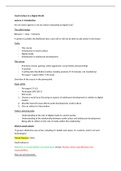Youth Culture in a Digital World
Lecture 1: Introduction
Are we active agents or are we robots responding to digital cues?
The selfish ledger
Behavior -> data -> behavior
A system to predict the likelihood that a user will or will not be able to take action in the future.
Today
- This course
- Introduction in youth culture
- Digital media
- Introduction in adolescent development
This course
- 8 lectures (music, gaming, online aggression, social media and parenting)
- 4 tutorials
- 5 writing labs (facultative) (online, booking sessions of 10 minutes, not mandatory)
- Pre-paper + paper (60%) + MC exam
Overview of the course in the powerpoint.
Paper (60%)
- Pre-paper (17-12)
- Final paper 60% (28-1)
- 850 words
1. Choose a social issue (focusing on aspects of adolescent development in relation to digital
media)
2. Describe how this issue affects youth development/ youth culture
3. Give an advice for intervention
Today’s learning goals
- Understanding of the role of digital media in current society
- Understanding of the relationship between youth culture and adolescent development
- Being able to reflect on the role of media within this relationship
What is youth culture
“A group’s distinctive way of live, including it’s beliefs and values, it’s customs, and it’s art and
technologies”
Talcott Parsons (1964)
Youth culture is:
Hedonism & irresponsibility (and adventure) Versus. Routine, delay of gratification and
responsibilities.
They are all connected…
,Adolescent development, digital media & Youth culture.
Example: Adolescent development (Risk behavior as part of normal development), youth culture
(Risk behavior as expression), digital media (Risk behavior by the use of digital media)
Youth culture unwritten rules
The digital world has it’s own jargon as well as “rules” about how to behave.
How are youth culture and digital media connected?
Music festivals, game events.
Documentary:
Two messages:
- Less different youth cultures than 2 decades ago
- Social media plays an important role. We need to prepare the youth to use the benefits of
social media, but be aware of the risks.
Youth culture and media, is there a mobile youth culture?
- Separate social position characteristic for youth culture
- “Generational distinctiveness” through digital media (generation can separate themselves
from earlier generations)
o Though also so connected…
- Also recognize the existence of subcultures within (Brake, 2013)
Youth culture, youth development and media (Mchale et al., 2009)
- Parents
- Peers
- Schools
- Neighborhood
- Availability of media use
- … and permission to use media
,Part 3: Digital media use
Social media use 12-16 years (Source: HBSC-Netherlands, 2017; Stevens et al., 2017)
- Social media use becomes more as the youngsters grow up
- Preference for online contact increases with age
- Problematic social media use increases a little with age, but decreases at 16
Examples of problematic use:
- Loss of control/not being able to stop
- Losing interest in other activities
- Conflict parents
- Problems at school
Do you feel addicted to social media use (12-15 years) (Source: Digital Youth Project 2017; van der
Eijnden et al. 2017)
2018:
- 22% of the girls feels quite well/definitely addicted
- 11% of the boys feels quite well/definitely addicted
Gaming? (Source: HBSC-Netherlands, 2017; Stevens et al., 2017)
2018:
- 96% of the boys played a game in last three months
- 70% of the girls played a game in last three months
Part 4: Adolescent development
They are all connected
Adolescent development:
- Identity
- Social relations
- Emotion & well being
- Problem behavior
Emerging adulthood… Identity formation
- Who are you?
- What are your beliefs?
- What is your position in this world?
- Who do you want to be?
Erikson’s theory (1902-1994)
- Life phases are characterized by “crisis”. Adolescence = identity versus identity confusion
- “Healthy path” = stable and secure identity
Youth culture, media and identity formation
Youth (sub)cultures can support identity formation:
, - Support intimate interactions with others
- Self-exploration and trying different “selves” (self-concept)
- Provide possible role models (Bandura’s social learning theory)
- Create feelings of ingroup and outgroup favoritism (Social Identity Theory Tjafel)
Social relations
- Friendships
- Romantic relations
- Peer influence
- Social status & popularity
Social relations, youth culture & digital media
Youth culture can support in connecting:
- Meeting similar others (values, beliefs, behavior)
- Shared preferences (music, social networks) increase friendship stability and formation
- Learn from role models (easier when you feel connected/similar)
Why YouTube stars influence millennials more than traditional celebrities (social cognitive theory,
Bandura)
Emotion, well-being and youth culture
Youth culture can support in:
- Need to belong
- Social capital or social support
- Acceptance
- Mood regulation
Problem behavior, media and youth culture
Always supportive?
Selection effects? Is music causing people to be more delinquent/depressed, or do people who have
similar personality traits select each other.
Delsing et al., 2007.
What about the role of digital media?
- Explore identity by looking at vloggers or “like” certain groups
- Connect to others and strengthen relationships by facebook
- Feel better while listening to music or release stress by playing games
- Behave to the norms of certain music groups or copy vloggers
Lecture 2: Digital Media Theories
Media theories
1. Media use
2. Media effects





